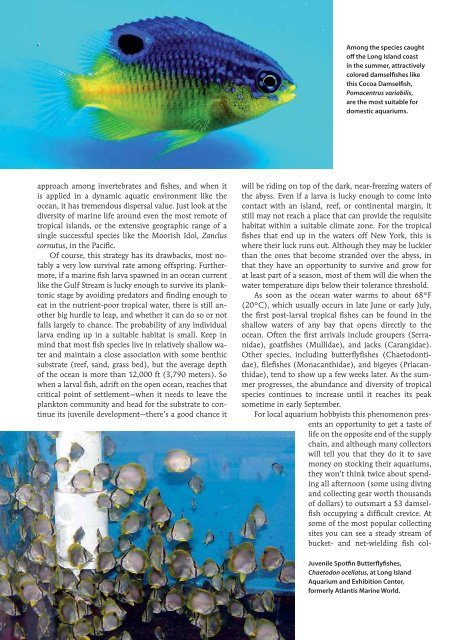Create successful ePaper yourself
Turn your PDF publications into a flip-book with our unique Google optimized e-Paper software.
Among the species caught<br />
off the Long Island coast<br />
in the summer, attractively<br />
colored damselfishes like<br />
this Cocoa Damselfish,<br />
Pomacentrus variabilis,<br />
are the most suitable for<br />
domestic aquariums.<br />
approach among invertebrates and fishes, and when it<br />
is applied in a dynamic aquatic environment like the<br />
ocean, it has tremendous dispersal value. Just look at the<br />
diversity of marine life around even the most remote of<br />
tropical islands, or the extensive geographic range of a<br />
single successful species like the Moorish Idol, Zanclus<br />
cornutus, in the Pacific.<br />
Of course, this strategy has its drawbacks, most notably<br />
a very low survival rate among offspring. Furthermore,<br />
if a marine fish larva spawned in an ocean current<br />
like the Gulf Stream is lucky enough to survive its planktonic<br />
stage by avoiding predators and finding enough to<br />
eat in the nutrient-poor tropical water, there is still another<br />
big hurdle to leap, and whether it can do so or not<br />
falls largely to chance. The probability of any individual<br />
larva ending up in a suitable habitat is small. Keep in<br />
mind that most fish species live in relatively shallow water<br />
and maintain a close association with some benthic<br />
substrate (reef, sand, grass bed), but the average depth<br />
of the ocean is more than 12,000 ft (3,790 meters). So<br />
when a larval fish, adrift on the open ocean, reaches that<br />
critical point of settlement—when it needs to leave the<br />
plankton community and head for the substrate to continue<br />
its juvenile development—there’s a good chance it<br />
will be riding on top of the dark, near-freezing waters of<br />
the abyss. Even if a larva is lucky enough to come into<br />
contact with an island, reef, or continental margin, it<br />
still may not reach a place that can provide the requisite<br />
habitat within a suitable climate zone. For the tropical<br />
fishes that end up in the waters off New York, this is<br />
where their luck runs out. Although they may be luckier<br />
than the ones that become stranded over the abyss, in<br />
that they have an opportunity to survive and grow for<br />
at least part of a season, most of them will die when the<br />
water temperature dips below their tolerance threshold.<br />
As soon as the ocean water warms to about 68°F<br />
(20°C), which usually occurs in late June or early July,<br />
the first post-larval tropical fishes can be found in the<br />
shallow waters of any bay that opens directly to the<br />
ocean. Often the first arrivals include groupers (Serranidae),<br />
goatfishes (Mullidae), and jacks (Carangidae).<br />
Other species, including butterflyfishes (Chaetodontidae),<br />
filefishes (Monacanthidae), and bigeyes (Priacanthidae),<br />
tend to show up a few weeks later. As the summer<br />
progresses, the abundance and diversity of tropical<br />
species continues to increase until it reaches its peak<br />
sometime in early September.<br />
For local aquarium hobbyists this phenomenon presents<br />
an opportunity to get a taste of<br />
life on the opposite end of the supply<br />
chain, and although many collectors<br />
will tell you that they do it to save<br />
money on stocking their aquariums,<br />
they won’t think twice about spending<br />
all afternoon (some using diving<br />
and collecting gear worth thousands<br />
of dollars) to outsmart a $3 damselfish<br />
occupying a difficult crevice. At<br />
some of the most popular collecting<br />
sites you can see a steady stream of<br />
bucket- and net-wielding fish col-<br />
Juvenile Spotfin Butterflyfishes,<br />
Chaetodon ocellatus, at Long Island<br />
Aquarium and Exhibition Center,<br />
formerly Atlantis Marine World.<br />
88 CORAL

















